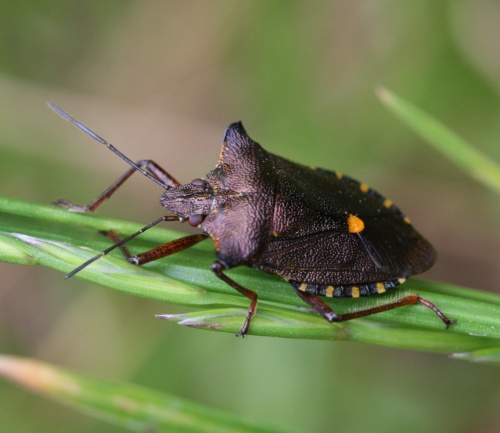
Shieldbugs are large and colourful insects that are relatively easy to identify. Like all true bugs they have piercing mouthparts which are used to suck up food from either plants or prey. They get their common name from their shape which resembles a medieval shield. Some are specialists and usually only found on their host plant, but others are generalists and can be found anywhere. They like to sun-bathe so look on leaves and other vegetation to spot them. Juvenile shieldbugs (nymphs) can look very different to the adults. The species below are adults of the most commonly recorded shieldbugs on NatureSpot. View the NatureSpot gallery of all Leicestershire and Rutland shieldbugs. If you spot any of these species, submit a record.
Common Green Shieldbug
This is the most common shieldbug and is often found in gardens. Adults overwinter and change colour to a bronzy brown to camouflage them in dead vegetation (image below). Nymphs feed on the leaves of several trees but favour Hazel.
How to ID: Large - to 13mm. Bright green with red antennae.
Where to see it: On or under leaves in trees and shrubs in any well vegetated area.
Similar species: None (in their summer green colour).
Hairy Shieldbug
Also called a Sloe Bug as they like to feed on Blackthorn fruits (sloes). They also feed on a wide range of other plants. Adults hibernate through the winter so can be seen if the weather is particularly warm.
How to ID: 10-13mm. Purplish brown with black and white chequers along the edges. It is covered in fine hairs.
Where to see it: Parks, garden, hedgerows. Can be seen in all months.
Similar species: The uncommon Brown Marmorated Shieldbug has a row of white spots across its back.
Hawthorn Shieldbug
This striking shieldbug overwinters as an adult, emerging and mating in the spring. The nymphs feed mainly on Hawthorn berries, although a range of other deciduous trees are also used, including Oak, Hazel and Birch. Adults may become darker before hibernation.
How to ID: 13-15mm. Brown pattern on green. The pointed 'shoulders' are often red. The scutellum (central triangle) is green.
Where to see it: Around Hawthorn and other food trees.
Similar species: The Birch Shieldbug has a scutellum flushed red.
Red-legged Shieldbug
This shieldbug is partly predatory, feeding on caterpillars as well as fruit. It overwinters in trees as a nymph.
How to ID: To 14mm. Brown with orange/cream spots along its hind margins and a central orange spot. Red legs and pointed 'shoulders'.
Where to see it: Woodland, shady places and gardens.
Similar species: No other shieldbug has these colours and patterns.
Birch Shieldbug
This species overwinters as an adult, emerging and mating in the spring. The nymphs feed principally on Birch, but may also be found on Hazel and Aspen; the new generation is complete by August.
How to ID: 8-11mm. Red markings on a green-yellow background. Scutellum with a red flush in parts.
Where to see it: Around Birch trees.
Similar species: The Hawthorn Shieldbug is more elongate and has a completely green scutellum with no red flushing.
Woundwort Shieldbug
This small, rounded shieldbug is unlike any others. It has one generation per year with the over-wintering adults mating and laying eggs in spring/early summer. The nymphs feed on Hedge Woundwort and White Dead-nettle.
How to ID: 5-7mm. Silvery with copper markings and black and white edges.
Where to see it: Hedges and woodlands on Hedge Woundwort and White Dead-nettle.
Similar species: None.



